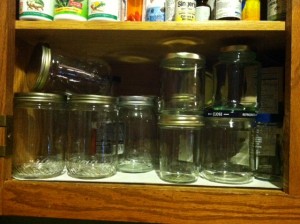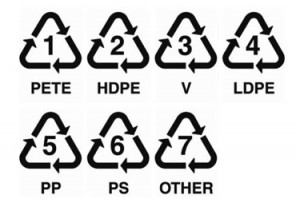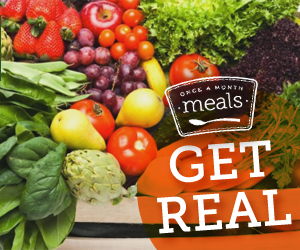**This post is part of the Get Real series. Please remember that this is meant as a learning community. We know that many of you are passionate about what you do and we want you to express that, just please do so in a way that will be an encouragement and aid to others making a transition. We want this to be a “safe space” for participants to learn. For that reason, we reserve the right to delete any comments that are not handled in this manner.
I should be upfront with you and tell you that I intentionally no longer use plastic containers if I can help it. There is very little plastic left in my home where the kitchen, food, and drink are concerned. In this discussion I am biased, but that’s just me. Here at my house, we use a lot of glass jars. Since we are constantly purchasing grocery items that are stored in glass jars, we have a steady stream of storage containers coming into the house. We don’t use Tupperware, or plastic food containers. We just use the glass jars left from our grocery purchases. My husband and I have gotten more than a few questions about why we are drinking our coffee or chai out of a Mason jar. They are just our container of choice.

My glass jar shelf
A little about glass: Consider a glass bottle, which is essentially melted sand. It is likely already made up of at least 25% recycled glass, plus some new glass material. Once that glass bottle is recycled, it is ground up into small pieces forming a material called “cullet”. Cullet can be mixed with sand, soda ash, and limestone to form new glass containers. Glass never wears out, can be recycled time after time without losing its integrity, and is 100% recyclable. Plus, glass has been shown to preserve the quality and flavor of foods and lengthen shelf-life better than plastic.
One ton of recycled glass saves 1.2 tons of raw materials needed to manufacture the glass. Cullet can be used to make new glass containers, fiberglass insulation, concrete, polymer composite sewer pipe, brick, and terrazzo (flooring material). It can also be used as a filler in paving for making a road surface called “glassphalt.” Where I live in the Midwest, we have a major glass recycling center that grinds glass into powder-fine material to be used mostly for making fiberglass. Glass for recycling is in high demand here.
Now let’s compare plastic: Plastic resins are made from petroleum, natural gas, and coal derivatives called olefins. Every time a product is packaged in a plastic container, it is new plastic. All new resources went into making that container. One of the disappointing things about plastic is that once it is used the first time, it will no longer possess the same quality. Plastic loses its integrity each time it is recycled. For example, the first time a plastic is produced, it could be a plastic soda bottle, but once it goes through the recycling process it is then turned into something like fleece fabric, the fiberfill in your sleeping bag, or even a reusable grocery bag. It can never again be something as strong and durable as it was when it was in its original form. This is called downcycling. It’s like making a photocopy of a photocopy. The quality continues to decrease each time.
When food is stored in plastic, it can absorb smells and alter taste because it is so permeable. Some studies show that plastic (namely the additives that alter color and durability) can leach into your food, especially foods that are hot or foods that are high in fat content. There is evidence that leached plastic can disrupt hormones as well. Have you heard of BPA (aka bisphenol-A)? BPA is an ingredient used to make some plastics. It exhibits hormone-like properties and raises concern about its suitability in consumer products and food containers. Since 2008, several governments have questioned its safety, which prompted some retailers to withdraw polycarbonate products. A 2010 report from the United States Food and Drug Administration (FDA) warned of possible hazards to fetuses, infants, and young children. In September 2010, Canada became the first country to declare BPA a toxic substance. The European Union, Canada, and recently the United States have banned BPA use in baby bottles.
Some research suggests that BPA exposure is linked to an increased risk of cardiovascular disease and diabetes. While most PET water bottles don’t contain BPA, #3 or #7 plastics may, according to the U.S. Food and Drug Administration. The FDA continues to monitor the research on BPA. Unfortunately, BPA is still widely used and is found in the linings of most canned goods as well.
It is important to remember that plastic was originally developed to be material for permanent products. Plastic is basically immortal and was never meant to be the primary material for disposable products. It lives on indefinitely, and this is the reason we must make plastic recycling a priority. It will continue to live on wherever it ends up–whether that be in the landfill, floating around in the ocean, lying in a roadside ditch, or hopefully when it is recycled into a new product. Please recycle when you do use plastic!
Some important things to remember when it comes to plastic: Do not microwave plastic or put hot food or drink in plastic. It can leach into your food. Storing high-fat foods in plastic can cause leaching. Recycle or re-purpose old, worn-out, or scratched plastic containers for non-food use. Plastic particles can easily make their way into your food when the container is damaged. It is best to hand wash plastic. If you cannot hand wash your plastic food containers, be sure to put them on the highest rack of your dishwasher to minimize exposure to intense heat. Do not give your baby any plastic teething toys. Avoid the use of #3 plastics (aka PVC) whenever possible. According to Greenpeace, “this commonplace plastic is one of the most toxic substances saturating our planet and its inhabitants. PVC contaminates humans and the environment throughout its lifecycle: during its production, use, and disposal. Few consumers realize that PVC is the single most environmentally damaging of all plastics. Since safer alternatives are available for virtually all uses of PVC, it is possible to protect human health and the environment by replacing and eventually phasing out this poison plastic.”
Avoid using styrofoam (one kind of #6 plastic) whenever possible, especially for hot food and drinks. It is unsafe, and also not recyclable (though the bottom of the container says it is). Bring your own take-out containers when you anticipate bringing home leftovers from a restaurant (we use this one). Avoid using #7 plastics as much as possible–it is a mixed bag and you never quite know what kind of plastic is included in the mix. This type of plastic is not easy to recycle and most likely ends up in the landfill. Just remember this little rhyme regarding plastic numbers (found on the bottom of most plastic containers): “1, 2, 4, 5- use ‘em and you stay alive; numbers 3, 6 and 7- use ‘em and go straight to heaven”. Plastics with the numbers 1, 2, 4, or 5 are considered safer and are much easier to recycle.  Want to know more about what all the plastic numbers mean? Here’s a great explanation of the different recycle symbols and what they each mean. As we’ve said here at Get Real many times before, you can learn a lot from what your package says!
Want to know more about what all the plastic numbers mean? Here’s a great explanation of the different recycle symbols and what they each mean. As we’ve said here at Get Real many times before, you can learn a lot from what your package says!
October Week 4 Action Item:
- Take a look at the plastic containers in your food storage arsenal. Check and read about the various plastic numbers and what they mean. Be an educated consumer!
October Get Real:
Please take a moment to thank our guest authors by clicking over to their sites and/or liking them on Facebook and/or Twitter.
Sponsor: Once A Month Meals
1 Comment
Join the discussionI would refer glass container due to their non-reactive nature which helps in keeping the food fresh and fresh from contamination.